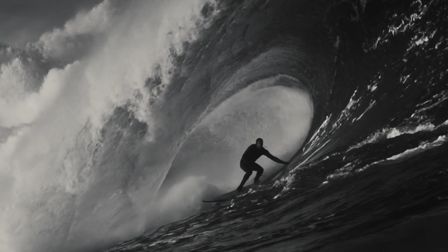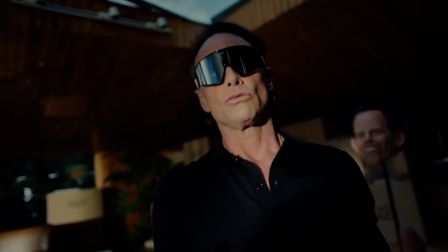Tagholm & Hunt Go Behind the Scenes on TalkTalk
Tom Tagholm and Danny Hunt take us through their new documentary-style campaign for TalkTalk.
Credits
powered by
- Agency The&Partnership London/UK
- Production Company Park Pictures
-
-
-
Unlock full credits and more with a Source + shots membership.
Credits
powered by
- Agency The&Partnership London/UK
- Production Company Park Pictures
- Music Leland Music
- Editing Company Stitch
- Post Production MPC London
- Editor Tim Hardy
- Director of Photography Luke Scott
- Art Director Marc Donaldson
- Agency Producer David Jones
- Executive Creative Director Jonathan Burley
- Executive Producer Stephen Brierley
- Creative Dan Watts
- Creative Danny Hunt
- Creative Rob Webster
- Production Manager Ananda Grace
- Director Tom Tagholm
- Producer Fran Thompson
- Creative Director Jim Bolton
- Post Producer Amy Richardson
- Colourist George Kyriacou
- Creative Partner Micky Tudor
- Head of Art Buying
- Head of Art Buying
- Production Assistants
- Production Assistants
- Production Assistants
- Production Assistants Hannah Greene
- Creative Producer

Credits
powered by
- Agency The&Partnership London/UK
- Production Company Park Pictures
- Music Leland Music
- Editing Company Stitch
- Post Production MPC London
- Editor Tim Hardy
- Director of Photography Luke Scott
- Art Director Marc Donaldson
- Agency Producer David Jones
- Executive Creative Director Jonathan Burley
- Executive Producer Stephen Brierley
- Creative Dan Watts
- Creative Danny Hunt
- Creative Rob Webster
- Production Manager Ananda Grace
- Director Tom Tagholm
- Producer Fran Thompson
- Creative Director Jim Bolton
- Post Producer Amy Richardson
- Colourist George Kyriacou
- Creative Partner Micky Tudor
- Head of Art Buying
- Head of Art Buying
- Production Assistants
- Production Assistants
- Production Assistants
- Production Assistants Hannah Greene
- Creative Producer
Yesterday saw the release of a new TalkTalk caign from CHI&Partners London which gives a glimpse into how modern families interact, especially around technology.
Essentially a 60 second hero film [top] plus a series of documentary-style vignettes of one family, the caign, called This Stuff Matters, was created using an array of hidden cameras and microphones and meant a hands-off approach for the agency and Park Pictures director, Tom Tagholm.
Below, Tagholm and one of the creatives behind the caign, Danny Hunt, explain its inception, how they found the right family and the difficulty of not really doing anything...
How did you come to the concept of, essentially, a family-based reality TV caign?
DH: We imagined shifting our focus from treating TalkTalk as a provider of entertainment and connectivity, to a ‘must-have’ utility provider.
Today, TV, mobile and broadband have become necessities within everyday life – they’re the things that we gather around. They make us laugh, cry, they bring us together and keep us there. Not to mention the weekly shop. So, with that in mind, we came up with the line first… ‘This is the stuff that matters’.
And once we had decided we wanted this to be the focus of the caign, approaching it as a documentary – filmed for real from unmanned cameras – seemed the best and most honest way to prove this point.

Tom Tagholm, in the red cap, holed-up in the garage watching the family's garage, watching the monitors.
Were there any particular inspirations behind the caign?
DH: We looked to reality TV shows like Educating Yorkshire, First Dates and The Family for inspiration. Not to mention my own family.
One of the first exle scripts we came up with came from my daughter Emmylou singing the song from the film Frozen. It’s super-cute but also quite bad at the same time. One of them moments that are only great if they’re real.
Tom, what did you think when you first saw the script… or indeed, lack of script?
TT: There actually were scripts - at least guide ideas which kind of sold the overall thought. I responded to those, while at the same time knowing that we'd not really have any scripts at all when it came to it. That sense of the unknown appeals. Not falling into patterns, kind of wilfully rejecting that.
But, on the other hand, you could say it's exactly what I'm drawn to, at least in term of texture. I want to work on ideas that are to do with truth and performance and guess you don't get any more real and truthful than this.
Here's the thing though - I like to separate the idea from the execution and not confuse the two. The idea was to see how people really use TalkTalk. What do people do when they're on the phone, how do you use a tablet- or watch the telly outside of adverts? We talked about losing the charger - that was kind of a start point or a touchstone. You don't see that in commercials and yet it something that we all instantly connect to.

CHI&Partners creative, Danny Hunt.
As a director, how do you approach something like this; how much actual direction did you/could you give?
TT: I wanted to actually force myself to do even less than you would on a documentary piece. All of the wisdom is that you should at least engineer certain story lines - that's how they like to do it. I wanted to just put all the work in up front, travel the country and meet these human beings. Often not even taking a camera - I wanted to see them in a way that was unfiltered as possible.
Then I drove everyone bonkers with a series of really restrictive rules for myself and all of us. I knew we'd blow it if we started directing, or creative directing. So, I removed myself from talking at all to the family after the first meeting. I don't even think I told them how good I thought they were - which is what you'd normally do. I didn't want anything that could get in the way of them being themselves.

We weren't allowed to move any furniture, not even by an inch. The kitchen set up was horribly awkward to shoot, but if we made it more friendly for our coverage I think it would have opened an ugly creative can of worms. What about a new sofa. What about stuff with no logos. Hey, could we have a look at the colour of that wall….
Nah, that wasn't interesting, so we had to be brutal from the word go. If I did any directing, it was in making that list. Other than that, I sat back put the cameras in the right place and wondered at the show that was unfolding in front of our eyes.
How did you find the family in question and what was that casting process like (also, there’s no mention of the family’s last name; is that on purpose)?
DH: Treating this like a TV show rather than a commercial was the key to the whole job. We used a casting director who’s done a lot of stuff for Channel 4, and opened up the opportunity to all TalkTalk customers, using direct email and social media. We asked each family that applied to send us home videos introducing themselves.
Tom [Tagholm] then travelled up and down the country to visit all the families, putting together a shortlist of about 10 families. And finally, we chose our favourites. We opted to use only first names throughout the caign for security reasons. It’s the only part of the caign that isn’t transparent. Well that and the full address.
What was the client’s initial reaction to the idea; were they on board with it from the start?
DH: Our clients have been excellent from the start. They bought into it straight away. To buy into an idea that doesn’t have any real scripts is a massive leap of faith – in both the big idea and in us. Hats off to them – it was a brave move.
How much eventual footage was there and did your job begin in the edit suite even more so than usual?
The edit was exactly why I love working with Tim Hardy when I can. And when he'll have me. He took all our logs and pretty much shredded them. We had tens of geniuses looking out for cool stuff over the shoot, and meticulously logging.
He instinctively knew what he was looking for and it meant going through everything. Regardless. You can think it's about big spikes - an argument, a funny piece of dialogue - and it is sometimes this. But you want a flow and you want light and shade always in your film. Drinking a cup of tea, looking out the window, nothingness - stuff that wouldn't trouble the radar when logging the action. But when woven into a bigger story these moments become as poignant or important as anything else you could hope to shoot.

What was the most difficult aspect of the process?
DH: Not meddling was tricky. We made a decision at the start of the process that what happens in the family household is the ad. No fixing, no adjusting or art directing. If the camera angle is off, we don’t fix it in post. If the sound is bad, we leave it. If their room is too dark, or the wrong colour - that’s their room, so that’s what makes it good.
Bad is good. Wonky is right. It sounds simple but it takes a bit to get used to it.
TT: Hard elements? Truthfully not so many. Sound is tricky, I didn't want radio mic for obvious reasons. So it involved a lot of clever hiding of a world of mics - something we ended up taking for granted as a decision but which worked well.
Also those blue festival-style toilets were grim - we were holed up in a garage next door with two of those to go around. Like odd neighbours. Eating takeaways in the cold and watching 20 monitors.
And the most rewarding?
DH: Seeing the clients’, and our own, blind belief in the idea pay off.
TT: Apart from a family of films I'm immensely proud of I learned this: I'm no good at relaxing. And neither is my family - I blame it on them. I watched this amazing family never be afraid to sit and hang out. They all had a million things on, in lots of different ways, but when the time was right, they were brilliant at just being. Some telly, some banter, some toast, some lunacy. It's a really underrated skill and kind of beautiful to watch.
Connections
powered by
- Agency The&Partnership London
- Editing Company STITCH
- Music Leland Music
- Post Production MPC London
- Production Park Pictures
- Agency Producer David Jones
- Art Director Marc Donaldson
- Colourist George Kyriacou
- Creative Rob Webster
- Creative Danny Hunt
- Creative Dan Watts
- Creative Director Jim Bolton
- Creative Partner Micky Tudor
- Director Tom Tagholm
- Director of Photography Luke Scott
- Editor Tim Hardy
- Executive Creative Director Jonathan Burley
- Executive Producer Stephen Brierley
- Creative Producer Ruby Hill
- Head of Art Buying Emma Modler
- Production Assistants Alfie Glover-Short
- Production Assistants Hannah Greene
Unlock this information and more with a Source membership.
)










